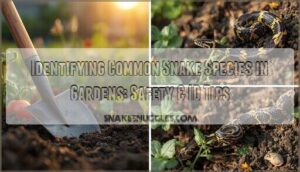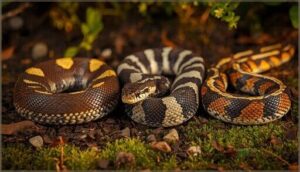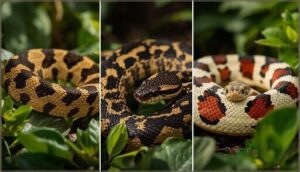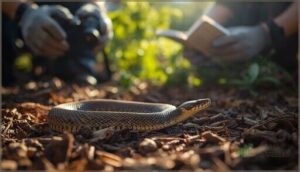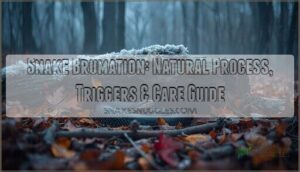This site is supported by our readers. We may earn a commission, at no cost to you, if you purchase through links.
Last summer, a neighbor nearly beheaded a harmless garter snake with a shovel, mistaking it for a copperhead. The confusion was understandable—both snakes share similar coloring in certain light—but entirely preventable.
Identifying common snake species in gardens doesn’t require a degree in herpetology, just a few reliable markers you can spot from a safe distance. Most garden snakes are beneficial pest controllers, gobbling up slugs, mice, and insects that would otherwise devour your tomatoes.
Learning to distinguish a helpful garter snake from the occasional venomous visitor protects both you and these often-misunderstood reptiles, turning panic into confident coexistence.
Table Of Contents
Key Takeaways
- Most garden snakes are harmless pest controllers that eat slugs, mice, and insects, but distinguishing them from venomous species requires checking for triangular heads, vertical pupils, heat pits between eyes and nostrils, and distinctive markings like hourglass bands on copperheads.
- Garter snakes—the most common garden visitors across North America—typically measure 22-30 inches with three yellow or white stripes, keeled scales arranged in 19 rows, and slender bodies that help them navigate dense vegetation while hunting.
- Safe identification starts with maintaining at least 6 feet of distance (two arm-lengths), since 56% of garden snakebites happen within 3 feet, and watching for defensive behaviors like body flattening, hissing, or open-mouthed strikes that signal you’re too close.
- A single garden snake can consume multiple rodents weekly without chemicals, making them valuable allies in natural pest control, though families with pets should install 36-inch hardware cloth barriers buried 6 inches deep and keep dogs leashed in grassy areas where snake encounters triple.
Key Features of Common Garden Snakes
When you spot a snake slithering through your garden, knowing what to look for can help you identify it quickly and stay safe. Garden snakes have specific physical traits that set them apart from other species, and learning these features takes the guesswork out of identification.
Let’s walk through the key characteristics you’ll want to check when you come across one of these backyard visitors.
Size and Body Shape
When sizing up a garden snake, length ranges matter: most garter snakes you’ll encounter measure between 22 and 30 inches, though some stretch to 51 inches. Females generally outweigh males—sometimes by 55%—giving them a stouter appearance. Their slender bodies, rarely exceeding 1.5 inches in diameter, reflect habitat adaptations for moving through dense vegetation.
Growth morphology shifts rapidly in their first year, with juveniles doubling in body mass when food’s plentiful. These snakes are essential for urban pest control.
Head and Neck Distinctions
Beyond length, head and neck distinctions help you nail garden snake identification. You’ll notice the head is wider than the neck—about 1.2 times in non-venomous types—creating that gentle taper. Knowing the difference in snake venom types is key to identifying venomous species.
Here’s what sets them apart:
- Head shape: Round versus the triangular venomous heads of pit vipers
- Neck markings: Black-necked garters sport distinctive dark patches
- Scale patterns: Ten to twelve lip scales frame the mouth
- Sexual dimorphism: Males often have broader jawlines than females
Scale Texture and Patterns
Once you’ve sized up the head, run your eyes over the scales themselves. Most garden snakes—especially garters—have keeled scales with a tiny ridge down the center, giving them a rough feel. You’ll spot 19 rows running lengthwise, with stripes sitting on the second and third scale rows.
Snake scale patterns can show asymmetry or checkering between stripes, thanks to genetic influence and regional variation. Look for labial markings—those black bars on light-colored lip scales—to confirm you’re identifying common snake species correctly.
Gender Differences in Appearance
Beyond appearance alone, snake gender differences reveal themselves in body size, tail length, and age. Female garter snakes grow about 30% longer—hitting greater snout-vent lengths—while males sport proportionally longer tails to house reproductive structures.
Head shape can vary subtly, though coloration patterns and snake markings stay consistent between sexes.
Females mature around three years; males clock in at one to two, creating size and gender differences you’ll notice in the field.
Color Variations and Markings
Garden snakes are like nature’s paint-by-numbers project—no two look exactly alike. The colors and markings you’ll spot can range from bright yellows and reds to subtle browns and grays, and these patterns are your best clue for figuring out what species you’re dealing with.
Let’s break down the most common color features you’ll want to watch for.
Stripe Colors and Patterns
When you’re trying your hand at snake identification, those signature stripes are nature’s color-coded name tags. Here’s what you’ll commonly spot on common garden snakes:
- Yellow stripes – the rockstar of the bunch, showing up in about 76% of North American garden snakes
- White stripes – more common in cooler northern regions, appearing in roughly 6% of eastern garter snakes
- Green stripes – a less flashy variant at around 8% of populations
- Orange and blue morphs – the rare gems, together making up just 7% of stripe color genetics
Regional stripe variations matter for snake species identification too. Western garter snakes flash brighter yellow dorsal stripes 20% more often than their eastern cousins, while checkered patterns pop up twice as much in eastern populations.
These stripe pattern development differences aren’t just pretty – they serve real adaptive functions, helping snakes regulate temperature and dodge predators. Understanding these snake markings makes identifying garden snakes way less intimidating, though stripe identification challenges still exist since colors can shift with age and environment.
Side Spots and Unique Markings
Spotting those distinctive side details separates backyard snakes at a glance. Garter snake spots run in two dark rows between the stripes, while Butler’s Garter shows similar black patterns between scale rows 2-4. Other species, like the Eastern Milk Snake, display red blotches bordered in black—a striking contrast to your typical garden visitor.
| Species | Side Marking Type | Scale Row Position |
|---|---|---|
| Common Garter | Black spots in rows | Stripes on rows 2-3 |
| Butler’s Garter | Dark spots, two rows | Stripe on row 3 |
| Eastern Milk Snake | Red blotches with black borders | Full body pattern |
Pattern variability adds complexity—some markings change with age or habitat. Non-garter species, such as the Eastern Kingsnake with its yellow crossbands, further aid in distinguishing venomous from nonvenomous snakes when identifying backyard visitors.
Regional Snake Species in Gardens
Where you live makes a big difference in which snakes you’ll spot slithering through your garden. From the familiar striped garter snakes that pop up coast to coast to some less welcome venomous visitors in certain regions, knowing your local species helps you identify what’s harmless and what needs respect.
Let’s break down the most common garden snakes by region so you know exactly what you’re dealing with in your backyard.
Eastern and Western Garter Snakes
Garter snakes are the MVPs of garden visitors—you’ll spot them across North America more than any other snake. Eastern garter snakes (Thamnophis sirtalis sirtalis) rock three bold yellow or white stripes against dark backgrounds, generally stretching 18–26 inches.
Their western cousins show stripe variation with reddish spots along their sides and slightly different scale counts—8 upper labials versus 7 in easterns.
Both species share habitat overlap in gardens, chomping on slugs and earthworms while maintaining stable conservation status.
Other Common Regional Species
Beyond garters, you’ll encounter fascinating regional specialists in your backyard. Plains garter snakes (Thamnophis radix) stretch 40–70 cm across prairie states, while corn snakes dominate southeastern gardens at 76–122 cm with distinctive orange blotches—often mistaken for copperheads.
Here’s your quick snake species identification guide:
- Plains Garter: Three yellow stripes, grassland habitats
- Corn Snake: Reddish blocks, non-venomous rodent control
- Massasauga Surveys: Rattlesnake varieties detected April–September in Midwest gardens
- Species Richness: 37+ garter types showcase remarkable snake regional distribution
Venomous Vs. Non-Venomous Snakes
Your first task in snake identification is spotting whether you’re dealing with danger—and fortunately, Mother Nature left us clear clues. Venomous snakes most often sport triangular heads, vertical pupils, and rough scale texture, while nonvenomous snakes show slender heads and round pupils. Check for pit presence between eye and nostril—a dead giveaway for vipers.
| Feature | Venomous Snakes | Nonvenomous Snakes |
|---|---|---|
| Head Shape | Triangular/spade-shaped | Slender, rounded |
| Pupil Shape | Vertical slits | Round |
| Scale Texture | Rough, ridged | Smooth, glossy |
| Tail Scales | Single row past anal plate | Double row |
Snake bites from venomous species cause severe envenomation in roughly 50% of cases, making proper snake safety critical. Meanwhile, about 79% of garden encounters involve harmless species—your garter snakes and rat snakes providing free pest control.
Safe Identification and Observation Tips
If you’ve spotted a snake in your garden, the first thing you need to know is how to identify it without putting yourself at risk. Getting a safe, accurate read on what you’re dealing with makes all the difference between a harmless encounter and a serious problem.
Let’s walk through the key behaviors to watch for, how far back you should stay, and the warning signs that tell you you’re looking at a venomous species.
Recognizing Snake Behavior
Understanding snake behavior helps you identify what you’re dealing with before reacting. When threatened, most garden snakes freeze first—about 65% stay motionless initially. You’ll notice defensive actions like body flattening, hissing, or quick retreats. Watch for warning displays: open-mouthed strikes mean back off.
Chemical signals guide their feeding habits and navigation. These movement patterns and snake characteristics make identifying backyard snakes easier and safer.
Keeping a Safe Distance
Once you’ve spotted a snake and observed its behavior, keeping your distance is the smartest move. Stay at least 6 feet back—that’s roughly two adult arm-lengths. Here’s your safe distance rationale:
- Hospital data shows 56% of garden snakebites happen under 3 feet away
- Defensive strikes increase sharply within 1 foot of the snake’s head
- Summer heat raises bite proximity risks by 40%
- Most incidents involve sudden contact in close quarters
Whether you’re dealing with venomous snakes or nonvenomous snakes, maintaining space gives you time for proper snake identification without triggering defensive reactions. Snake bite prevention starts with respecting their personal bubble—even harmless species will defend themselves when cornered.
Signs of Venomous Species
Once you’re safely back, look for the telltale signs that separate venomous snakes from harmless ones. A triangular head that’s wider than the neck is your first red flag. Check for vertical pupils—like a cat’s eye—rather than round ones. Heat pits between the eyes and nostrils mark pit vipers. Rattling sounds? That’s a rattlesnake’s warning system in action.
Copperheads display those distinctive hourglass bands across their bodies, while coral snakes flash bright red, yellow, and black rings. Recognizing venomous snakes through these physical markers is your best defense for snake bite prevention and snake safety in gardens.
Benefits and Precautions in Garden Settings
Now that you know how to identify and safely observe garden snakes, let’s talk about why having them around isn’t necessarily a bad thing—and how to keep everyone safe.
Snakes actually play some pretty helpful roles in your yard, though you’ll want to take a few precautions if you have kids or pets. We’ll cover the benefits they bring, practical safety measures, and when it’s time to call in a professional.
Ecological Roles and Pest Control
While you’re worrying about slugs munching your tomatoes, garden snakes are already on pest control duty. A single garter snake can devour multiple rodents weekly, protecting hundreds of plants from damage.
Garden snakes provide natural pest control, with a single garter snake consuming multiple rodents weekly to protect your plants
They also target insects and slugs—all without chemicals. By maintaining natural pest control, these snakes strengthen your garden’s ecosystem and support biodiversity.
It’s chemical-free gardening with a built-in workforce.
Safety Tips for Families and Pets
Protecting your family starts with smart habits. Snakebite risk peaks March to October, when over 150,000 U.S. pets face venomous bites annually. Here’s your defense plan:
- Pet Leash Strategies: Keep dogs leashed in grassy areas—unsupervised roaming triples encounter rates.
- Fence Effectiveness: Install 36-inch hardware cloth barriers, buried 6 inches deep.
- Supervise Children: Restrict access to brush piles and wood stacks immediately.
- Repellent Limitations: Skip chemical deterrents—studies show under 10% efficacy; physical barriers work better.
Prompt vet care ensures 95% survival for venomous bites.
When to Seek Professional Assistance
Some situations demand expert backup. If you can’t identify a snake or it shows defensive behavior, contact wildlife professionals immediately. Venomous snake ID errors cause 28% of garden bite incidents. Emergency call triggers include aggressive posturing, confined spaces, or unknown species near high-traffic zones.
Here’s when professionals are essential:
| Scenario | Risk Level | Action Required |
|---|---|---|
| Unidentified species near children | High | Immediate removal cost factors apply ($250–$600) |
| Defensive posturing or striking | Critical | Emergency snake removal and professionals |
| Snake in crawl space/wall void | Moderate-High | Specialized extraction needed |
| Repeated sightings (3+ weekly) | Moderate | Exclusion service + inspection |
| Protected species suspected | Variable | Legal compliance issues require licensed operator |
Bite incident response begins with distance—never attempt capture. Professional snake removal averages $340 nationally, though venomous cases run higher. When to seek professional help? Always choose safety over DIY risks. Licensed operators guarantee humane relocation and meet state regulations, with 8–12% of cases triggering conservation review.
Snake safety and education programs through local wildlife agencies offer free identification assistance, reducing snake bite risk through proper recognition before emergencies develop.
Frequently Asked Questions (FAQs)
What do garden snakes eat besides rodents?
Think of garden snakes as nature’s cleanup crew—they’ll munch on earthworms, slugs, frogs, salamanders, and insects like crickets.
Some aquatic species even grab fish and crayfish, while others occasionally snack on bird eggs.
How long do garden snakes typically live?
Garden snakes usually live 2–4 years in the wild due to mortality factors like predation, but captive longevity extends to 6–10 years with proper care, showcasing how snake habitats dramatically influence lifecycle stages.
When are snakes most active during the day?
Most snakes actively hunt during morning and late afternoon when temperatures hit their sweet spot—between 75°F and 95°F. They’ll shift to nocturnal patterns during scorching summers, avoiding midday heat entirely.
Do garden snakes hibernate in cold climates?
When winter temperatures plunge below 60°F, you’ll find garden snakes retreating underground into communal dens for brumation—a hibernation-like state where their metabolism slows dramatically, allowing survival through months of freezing conditions.
Can garden snakes climb fences or walls?
Yes, they can climb textured surfaces like wooden fences or brick walls. Climbing factors include body length and grip.
Smooth barriers at least 24 inches high with buried edges provide better snake prevention.
Conclusion
Picture yourself kneeling by the tomato beds, calmly watching a slender snake glide past—no shovel panic, just quiet recognition. That’s the payoff of identifying common snake species in gardens: you protect beneficial allies while keeping your family safe.
A triangular head means caution; stripes down the back usually mean friendship. Once you know the difference, your garden becomes less battlefield and more balanced ecosystem. The next snake you meet won’t trigger fear—just informed respect.
- https://portal.ct.gov/deep/wildlife/fact-sheets/common-gartersnake
- https://pmc.ncbi.nlm.nih.gov/articles/PMC11856666/
- https://www.nps.gov/articles/000/common-garter-snake.htm
- https://redinational.com/how-can-landscaping-be-used-to-deter-snakes/
- https://blogs.cdc.gov/niosh-science-blog/2019/07/09/snakes/

